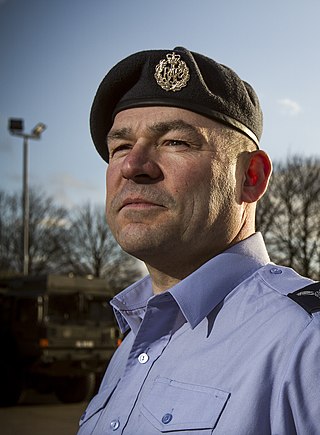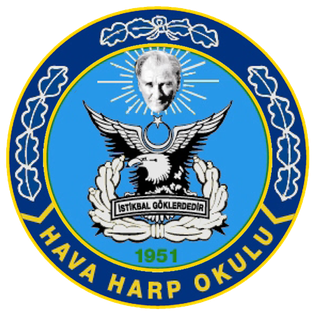
The Texas A&M University Corps of Cadets is a student military organization at Texas A&M University. Established with the university in 1876, it is the oldest student organization on campus.

Colour sergeant is a rank of non-commissioned officer found in several armies and marine corps.

A cap badge, also known as head badge or hat badge, is a badge worn on uniform headgear and distinguishes the wearer's nationality and/or organisation. The wearing of cap badges is a convention commonly found among military and police forces, as well as uniformed civilian groups such as the Boy Scouts, civil defence organisations, ambulance services, customs services, fire services etc.
Officer Cadet is a rank held by military cadets during their training to become commissioned officers. In the United Kingdom, the rank is also used by members of University Royal Naval Units, University Officer Training Corps and University Air Squadron; however, these are not trainee officers with many not choosing a career in the armed forces.

The Virginia Tech Corps of Cadets (VTCC) is the military component of the student body at Virginia Polytechnic Institute and State University. Cadets live together in residence halls, attend morning formation, wear a distinctive uniform, and receive an intensive military and leadership educational experience similar to that available at the United States service academies. The Corps of Cadets has existed from the founding of the Virginia Agricultural and Mechanical College in 1872 to the present-day institution of Virginia Tech, which is designated a senior military college by federal law. As of August 2021, about 1,200 cadets are currently enrolled in the program.
The Military ranks of Finland are the military insignia used by the Finnish Defence Forces. The ranks incorporates features from Swedish, German, and Russian armed forces. In addition, the system has some typically Finnish characteristics that are mostly due to the personnel structure of the Finnish Defence Forces. The ranks have official names in Finnish and Swedish languages and official English translations. The Swedish forms are used in all Swedish-languages communications in Finland, e.g. in Swedish-speaking units of Finnish Defence Force. The system of ranks in the Swedish Armed Forces is slightly different.

Full dress uniform, also known as a ceremonial dress uniform or parade dress uniform, is the most formal type of uniforms used by military, police, fire and other public uniformed services for official parades, ceremonies, and receptions, including private ones such as marriages and funerals. Full dress uniforms typically include full-size orders and medals insignia. Styles tend to trace back to uniforms used during the 19th century, although the 20th century saw the adoption of mess dress-styled full-dress uniforms. Designs may depend on regiment or service branch. In Western dress codes, full dress uniform is a permitted supplementary alternative equivalent to the civilian white tie for evening wear or morning dress for day wear – sometimes collectively called full dress – although military uniforms are the same for day and evening wear. As such, full dress uniform is the most formal uniform, followed by the mess dress uniform.

The Marine Military Academy is a private college preparatory academy located in Harlingen, Texas, US, offering a college preparatory curriculum for boys in grades 7–12 plus one year of post-graduate study. The school was founded in 1965. Its traditions and ideals are inspired by the United States Marine Corps (USMC), but the school is not affiliated with the USMC except through its Junior ROTC program.

Gorget patches are an insignia in the form of paired patches of cloth or metal on the collar of a uniform (gorget), used in the military and civil service in some countries. Collar tabs sign the military rank, the rank of civil service, the military unit, the office (department) or the branch of the armed forces and the arm of service.

The Turkish Air Force Academy (TAFA) is a co-educational military academy located in the city of Istanbul, Turkey. It is part of the National Defence University. It is the main human resource for the Turkish Air Force Command.

The Turkish Naval Academy is a four-year co-educational military academy and part of the National Defence University. It is located in the district of Tuzla in Istanbul. Its mission is to develop cadets mentally and physically for service as commissioned officers in the Turkish Navy. It must not be confused with Naval War Institute.
The uniforms of the United States Army distinguish soldiers from other service members. U.S. Army uniform designs have historically been influenced by British and French military traditions, as well as contemporary U.S. civilian fashion trends. The two primary uniforms of the modern U.S. Army are the Army Combat Uniform, used in operational environments, and the Army Green Service Uniform worn during everyday professional wear and during formal and ceremonial occasions that do not warrant the wear of the more formal blue service uniform.
Fikret Emek is a retired soldier from the Special Forces Command ; a special forces unit active in the Kurdish–Turkish conflict.

Troops began wearing berets as a part of the headgear of military uniforms in some European countries during the 19th century; since the mid-20th century, they have become a component of the uniforms of many armed forces throughout the world. Military berets are usually pushed to the right to free the shoulder that bears the rifle on most soldiers, but the armies of some countries, mostly within Europe, South America, and Asia, have influenced the push to the left.
The XI Corps of the Ottoman Empire was one of the corps of the Ottoman Army. It was formed in the early 20th century during Ottoman military reforms.
Joint War College, is an academic institution of the Turkish Armed Forces, founded in 1848. It was renamed the Armed Forces College in 1964, having previously been the Joint War College. It's renamed Joint War College again in 2016.
The Army War Institute, formerly Army War Academy, is an academic institution of the National Defence University. It is sometimes referred to in English as the Turkish Military College.
The uniforms of the Australian Army have changed significantly over the past century, although the accoutrements worn over this period have remained relatively similar. The forces of the Australian colonies and the early forces of the Commonwealth post-Federation in 1901 closely followed the uniforms of the British Army. Since then it has continued to be influenced by British but also US styles, as well as including some distinctly Australian designs, reflecting local conditions and trends.

The Indonesian Naval Academy is a service academy of the Indonesian Navy, the naval component of the Indonesian National Armed Forces Academy System or the AKABRI. Its campus is located in Surabaya, East Java and trains men and women to become officers of the Navy, including the Indonesian Marine Corps, Fleet Forces, Naval Aviation and support branches.
Lieutenant General Osman Erbaş was a Turkish army officer. He was a keen proponent of the use of unmanned aerial vehicles by the Turkish Army in anti-terrorism operations. In 2015 he was appointed commander of the 6th Mechanized Infantry Division and ordered his officers to remain loyal during the 15 July 2016 Turkish coup d'état attempt. Erbaş later testified as a witness at the trial of soldiers accused of joining the coup attempt. In 2017 he was appointed to command 8th Corps and while serving in this role was killed in a helicopter crash in 2021.
















